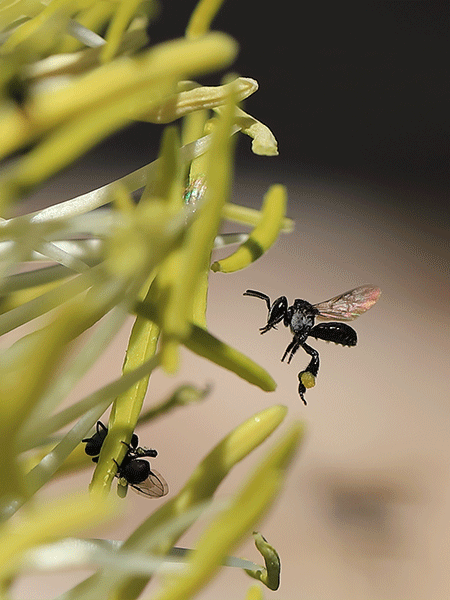– ABOUT
INTEGRATED PEST MANAGEMENT OMICS INITIATIVE
Through the creation of genomics data, this national program initiated in 2023 is set to transform our understanding of Australia’s diverse pest and beneficial insect populations and will play a pivotal role in supporting data informed integrated pest management (IPM) strategies in Australia.
Australia’s agricultural, forestry, and horticulture sectors, as well as its native ecosystems, are significantly impacted by insects, as beneficial contributors to ecosystem health and productivity, and as devastating pests and vectors of disease. Yet, despite their importance, the vast majority of insect species in Australia remain unidentified.
This initiative represents a significant step towards sustainable management of insect pests in Australia. Fostering research and creating data to increase Australia’s understanding of insects is a critical step in safeguarding agriculture and supporting healthy ecosystems. This initiative underlines the importance of omics data-informed, holistic approach to pest management.

OBJECTIVES
The data created in this initiative aims to support applications across:
-
-
- Accelerate insect identification: expedite identification of pest and beneficial insects to enhance monitoring, establish baselines, and identify unique native species.
- Expand knowledge of insect roles: deepen understanding of insect roles in ecosystems, including adaptation, cryptic species, extinction risks, and predator-prey dynamics.
- Support data-driven pest management: provide insights into insecticide resistance and the impacts of pest control on pollination and ecosystems.
-
DATA
For further information and to view and access initiative data, please go to the Bioplatforms Australia Data Portal.
PROJECTS
| Species name | Project Summary | Data Strategy | Project Lead | Partners |
|---|---|---|---|---|
| Slender furrow bee (Lasioglossum (Homalictus) dotatum) | The project is generating a platinum reference genome for Lasioglossum dotatum to identify genes linked to arid adaptation and desiccation resistance across climate gradients, supporting IPM and pollination in warming, drying climates. It is also investigating gene flow, trait evolution, and resilience to neonicotinoids in this vital pollinator. | Reference genome (PacBio HiFi, HiC), population genetics (Illumina short-read resequencing) | Carmen da Silva | Macquarie University, The University of Sydney, La Trobe University, Adelaide University |
| Stingless bee (Austroplebeia australis) | The project investigates Austroplebeia australis, a stingless bee species crucial for pollination in Australian horticulture. By examining population structure and the genomic basis of arid adaptation, this study is determining if various phenotypic morphs represent discrete populations or species and providing insights into climate resilience in bees. | Reference genome (HiC) | Ros Gloag | The University of Sydney, Macquarie University, The University of Queensland, La Trobe University |
| Blue banded bee (Amegilla pulchra) | The project focuses on Amegilla bees, promising alternatives to exotic bumblebees for pollination in Australasia due to traits like buzz pollination and Solanum flower fidelity. By developing genomic resources, the study is supporting conservation, agro-ecological management, and IPM, with research on sensory ecology, foraging, nesting behaviour, and host-plant interactions. | Reference genome (PacBio HiFI, HiC), population genetics (Illumina), transcriptomics (Illumina) | Simon Tierney | Western Sydney University, United States Department of Agriculture, Wayne State University, CSIRO - Australian National Insect Collection |
| Native bee (Exoneura angophorae) | Exoneura angophorae are common and ecologically significant bees in temperate Australia, known for pollinating apple crops and providing key agro-ecological services. Focusing on comparative evolutionary studies, the project explores functional pollination, social evolution, foraging and nesting behaviour, and adaptation to environmental gradients. | Reference genome (PacBio HiFI, HiC), population genetics (Illumina), transcriptomics (Illumina) | Simon Tierney | Western Sydney University, York University, Penn State University, United States Department of Agriculture, Wayne State University, CSIRO - Australian National Insect Collection |
| Sweat bee (Lasioglossum (Chilalictus) erythrurum) | This species is a key pollinator abundant in Australasian apple orchards. Aiming to support conservation and management, the project explores pollination, sensory ecology, foraging, social evolution, and biogeography. Focus areas include pesticide detoxification, host-plant interactions, immunity, and the unique “Australian Enigma” male dimorphism. | Reference genome (PacBio HiFI, HiC), transcriptomics (Illumina) | Simon Tierney | Western Sydney University, Princeton University, United States Department of Agriculture, , Wayne State University, CSIRO - Australian National Insect Collection |
| Australian fruit fly parasitoid (Diachasmimorpha kraussii) | This project is generating a reference genome for Diachasmimorpha kraussii, a native parasitoid of the Queensland fruit fly, to explore its diversity and host specialisation. By examining genomic differentiation across populations targeting various fruit fly species, this study enhances IPM and biologically informed control strategies against fruit flies and other fruit pests in Australia. | Reference genome (PacBio HiFI, HiC), transcriptomics (Illumina) | Joshua Thia | The University of Melbourne, Agriculture Victoria |
| Wingless grasshopper (Phaulacridium vittatum) | Phaulacridium vittatum is a native pest affecting pastures, orchards, vineyards, vegetable gardens, and native flora in south-eastern Australia. The study examines the pest's spread potential, invasiveness, and adaptive capacity by comparing mainland and isolated ‘island’ populations. | Reference genome (PacBio HiFI, HiC), Population genetics (Illumina short-read resequencing) | Sonu Yadav | Northern Territory Government, Macquarie University, CSIRO |
| Parasitoid wasps (Spalangia endius and Muscidifurax raptor) | These two parasitoid wasp species, Spalangia endius and Muscidifurax raptor, target house and stable flies for biocontrol. By exploring their genomic diversity and recombination maps, the project seeks to improve mass rearing efficiency and boost the effectiveness of these species as biocontrol agents. | Reference genome (PacBio HiFI, HiC) | Charles Robin | The University of Melbourne |
| Dongara weevil | The Dongara weevil threatens agriculture by damaging crops such as canola. Determining if it is native or invasive is crucial for management—eradication or containment if invasive, sustainable management if native. Genetic data will also be essential for identifying markers of adaptation and resistance to control methods, providing a foundation for effective pest management. | Reference genome (PacBio HiFI, HiC), transcriptomics (Illumina) | Wei Xu | Murdoch University, Western Sydney University, WA Department of Primary Industries and Regional Development, Grains Research and Development Corporation |
PARTNERS
hide
advisory committee members
Prof. Ary Hoffmann (Chair) – University of Melbourne
Prof. David Yates – CSIRO
Prof. James Cook – Western Sydney University
Dr Rachel Dudaniec – Macquarie University
Dr Andrew Weeks – Cesar Australia
Prof. Owain Edwards – Entozyme (formerly CSIRO)
Dr Sonu Yadav – Northern Territory Department of Industry
Prof. Dianne Gleeson – University of Canberra
Dr Jeff Christiansen – Australian BioCommons
Dr Kelly Scarlett – Bioplatforms Australia
CONTACT US
Project Manager
Aude Touffu – Bioplatforms Australia
atouffu@bioplatforms.com
Science Lead
Ary Hoffmann – University of Melbourne
Partnerships and Engagement Lead
Kelly Scarlett – Bioplatforms Australia
kscarlett@bioplatforms.com
